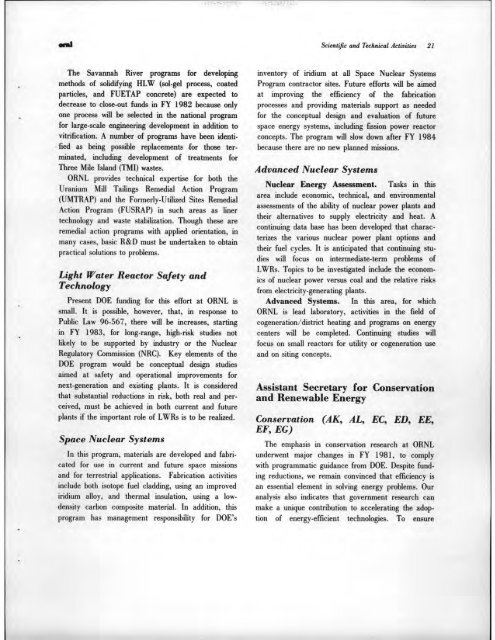Oak Ridge National Laboratory Institutional Plan: FY 1982-1987
Oak Ridge National Laboratory Institutional Plan: FY 1982-1987
Oak Ridge National Laboratory Institutional Plan: FY 1982-1987
Create successful ePaper yourself
Turn your PDF publications into a flip-book with our unique Google optimized e-Paper software.
The Savannah River programs for developing<br />
methods of solidifying HLW (sol-gel process, coated<br />
particles, and FUETAP concrete) are expected to<br />
decrease to close-out funds in <strong>FY</strong> <strong>1982</strong> because only<br />
one process will be selected in the national program<br />
for large-scale engineering development in addition to<br />
vitrification. A number of programs have been identi<br />
fied as being possible replacements for those ter<br />
minated, including development of treatments for<br />
Three Mile Island (TMI) wastes.<br />
ORNL provides technical expertise for both the<br />
Uranium Mill Tailings Remedial Action Program<br />
(UMTRAP) and the Formerly-Utilized Sites Remedial<br />
Action Program (FUSRAP) in such areas as liner<br />
technology and waste stabilization. Though these are<br />
remedial action programs with applied orientation, in<br />
many cases, basic R&D must be undertaken to obtain<br />
practical solutions to problems.<br />
Light Water Reactor Safety and<br />
Technology<br />
Present DOE funding for this effort at ORNL is<br />
small. It is possible, however, that, in response to<br />
Public Law 96-567, there will be increases, starting<br />
in <strong>FY</strong> 1983, for long-range, high-risk studies not<br />
likely to be supported by industry or the Nuclear<br />
Regulatory Commission (NRC). Key elements of the<br />
DOE program would be conceptual design studies<br />
aimed at safety and operational improvements for<br />
next-generation and existing plants. It is considered<br />
that substantial reductions in risk, both real and per<br />
ceived, must be achieved in both current and future<br />
plants if the important role of LWRs is to be realized.<br />
Space Nuclear Systems<br />
In this program, materials are developed and fabri<br />
cated for use in current and future space missions<br />
and for terrestrial applications. Fabrication activities<br />
include both isotope fuel cladding, using an improved<br />
iridium alloy, and thermal insulation, using a low-<br />
density carbon composite material. In addition, this<br />
program has management responsibility for DOE's<br />
Scientific and Technical Activities 21<br />
inventory of iridium at all Space Nuclear Systems<br />
Program contractor sites. Future efforts will be aimed<br />
at improving the efficiency of the fabrication<br />
processes and providing materials support as needed<br />
for the conceptual design and evaluation of future<br />
space energy systems, including fission power reactor<br />
concepts. The program will slow down after <strong>FY</strong> 1984<br />
because there are no new planned missions.<br />
Advanced Nuclear Systems<br />
Nuclear Energy Assessment. Tasks in this<br />
area include economic, technical, and environmental<br />
assessments of the ability of nuclear power plants and<br />
their alternatives to supply electricity and heat. A<br />
continuing data base has been developed that charac<br />
terizes the various nuclear power plant options and<br />
their fuel cycles. It is anticipated that continuing stu<br />
dies will focus on intermediate-term problems of<br />
LWRs. Topics to be investigated include the econom<br />
ics of nuclear power versus coal and the relative risks<br />
from electricity-generating plants.<br />
Advanced Systems. In this area, for which<br />
ORNL is lead laboratory, activities in the field of<br />
cogeneration/district heating and programs on energy<br />
centers will be completed. Continuing studies will<br />
focus on small reactors for utility or cogeneration use<br />
and on siting concepts.<br />
Assistant Secretary for Conservation<br />
and Renewable Energy<br />
Conservation (AK, AL, EC, ED, EE,<br />
EF, EG)<br />
The emphasis in conservation research at ORNL<br />
underwent major changes in <strong>FY</strong> 1981, to comply<br />
with programmatic guidance from DOE. Despite fund<br />
ing reductions, we remain convinced that efficiency is<br />
an essential element in solving energy problems. Our<br />
analysis also indicates that government research can<br />
make a unique contribution to accelerating the adop<br />
tion of energy-efficient technologies. To ensure

















